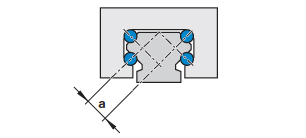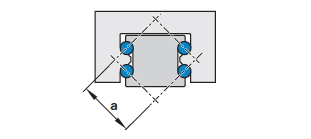As with most complex products or systems, specifying and applying profiled rail bearings doesn’t require that you know every detail of linear bearing construction. But having a basic understanding of the various design types and geometries can help you choose a product that enhances, rather than detracts from, the performance of your machine—especially in applications that require high moment load capacity, high rigidity, or extremely smooth travel.
Two design factors that determine a bearing’s performance characteristics are track geometry and raceway arrangement. Track geometry has a significant influence on the bearing’s friction and load capacity, while raceway arrangement determines the internal stresses on the rail and block and the amount of torsional moment loading the bearing can withstand.
Track Geometry
Most linear bearings use one of two track (or raceway) geometries—Gothic arch or circular arc, although there are variations on these two designs. The geometry of the raceway determines the number of contact points, which affects the friction in the block and the block’s load capacity.
Circular Arc
The circular arc design provides two-point contact between the ball and the raceway. Because there are only two points of contact, circular arc geometry requires two raceways on each side of the rail and block in order to provide bi-directional loading. Manufacturers who use a circular arc design do so because it has a lower differential slip, and therefore, a lower friction coefficient, resulting in smoother running characteristics. (For a primer on differential slip, check out MIT’s “Fundamentals of Design” topic 10, page 10-13.)

Image credit Bosch Rexroth. Used with permission.
Gothic Arch
The Gothic arch design provides four-point contact—two contact points on the ball and two contact points on the raceway. This four-point contact provides higher moment capacity and makes Gothic arch the preferred design for rails with only two raceways, such as miniature rails.
Because the differential slip is larger for Gothic arch than for circular arc designs, bearings with Gothic arch geometry will have a higher friction coefficient and require more force to overcome this friction. Applying preload to a Gothic arch design further increases this differential slip and causes even higher friction. (This is why miniature rails are rarely offered with a high preload option.) Misalignments in mounting can also impart preload, or unequal loading, on the bearing, so it’s important to ensure parallelism between mounting surfaces when using two or more rails with Gothic arch geometry.

Image credit Bosch Rexroth. Used with permission.
Raceway Arrangement
When using a profiled rail system with circular arc geometry, the arrangement of the raceways is another factor that influences linear guide performance. There are two arrangements, face-to-face (also known as the “X” design) and back-to-back (also known as the “O” design). The primary difference between the two raceway arrangements is the bearing’s ability to withstand torsional moments.
Face-to-Face
The face-to-face design is also known as the “X” arrangement because the contact lines between the balls and the raceways point inward, forming an “X” inside the rail. This arrangement offers equal load capacities in all directions and is more tolerant of mounting surface inaccuracies, but reduces the bearing’s ability to handle torsional moment loads.

Image credit Bosch Rexroth. Used with permission.
Back-to Back
The back-to-back design is also known as the “O” arrangement because the contact lines between the balls and the raceways point outward, forming an “O” around the rail. The larger moment arm produced by the back-to-back design provides greater torsional moment capacities and higher stiffness.

Image credit Bosch Rexroth. Used with permission.
For general automation applications, these distinctions typically won’t “make or break” the design. But in applications that call for extremely high rigidity, high moment capacity, or excellent running smoothness, taking into account the bearing geometry and track arrangement can help engineers ensure the linear bearing goes beyond providing the basic load capacity and accuracy and also contributes to the overall performance of the machine.


Good article. Thanks